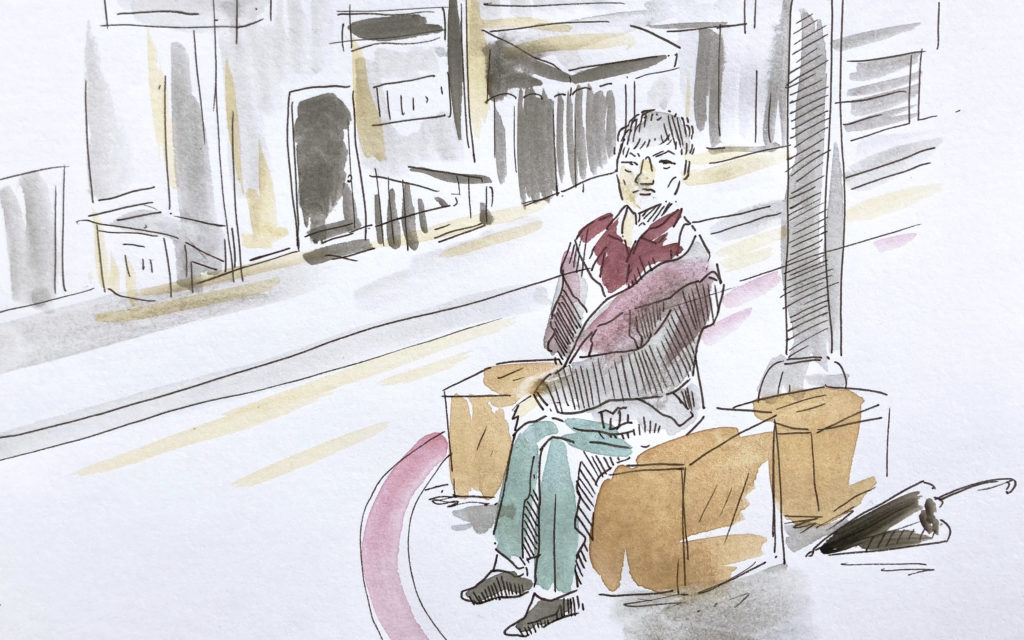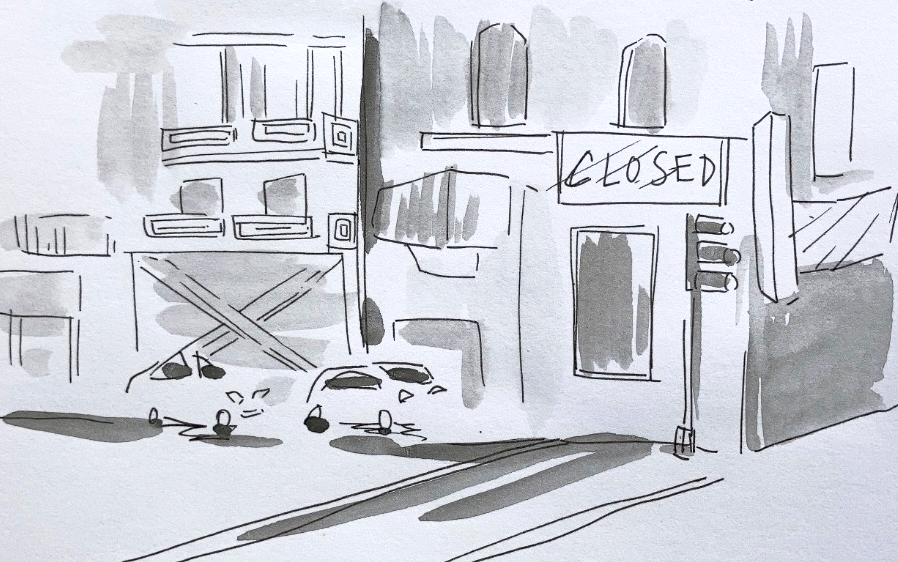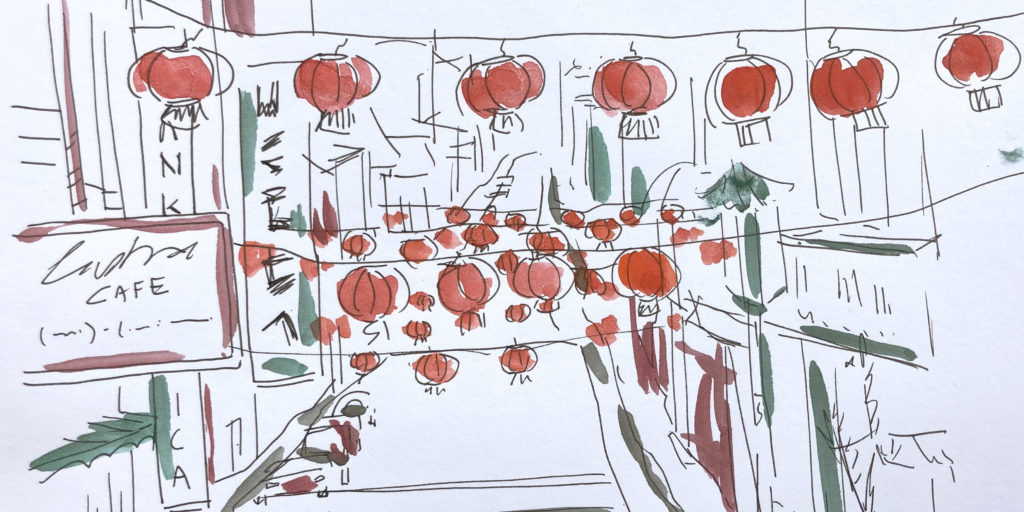Pagodas, lanterns, and, if you’re there on the right occasion, dragon and lion dancers — San Francisco’s Chinatown is a surprising delight in the heart of the city. The neighborhood’s extravagant facade not only entertains out-of-towners as San Francisco’s most popular tourist destination but provides a genuine haven for tens of thousands of Chinese residents. Following the historic earthquake of 1906, the neighborhood’s defenders made what may have seemed like a deal with the white devil: agreeing to transform Chinatown into a spectacle in exchange for remaining there, rather than being pushed to the outskirts of the city.
The fact that the deal continues paying off is apparent from photographer Dick Evans’s recently released photobook, San Francisco’s Chinatown. Taken before the onset of COVID-19, Evans’s photographs capture the vibrance and resilience of the oldest Chinatown in the United States, which has persevered through racism, gentrification, and natural disasters. Even so, the neighborhood may not be able to overcome the ongoing pandemic, which has caught it in a pincer of renewed Sinophobia and economic distress, making it especially vulnerable to encroaching development. Thus, Evans’s love letter to Chinatown might also be a fateful farewell.
I recently spoke with Evans about San Francisco’s Chinatown, the realities of life in the neighborhood, and how COVID threatens its future. Our conversation below has been lightly edited for clarity and brevity.
Arvind Dilawar: The moniker of San Francisco’s “Chinatown” can obscure the residents who live there, conflating immigrants from the Chinese mainland and Taiwan or Hong Kong, and erasing others who aren’t Chinese at all. Where do Chinatown’s residents hail from?
Dick Evans: According to the San Francisco Planning Commission, there are approximately 35,000 residents within the 24 square blocks of Chinatown. Of these, approximately 94 percent are ethnically Asian and very predominantly Chinese — and more specifically Cantonese from southern China. (From my encounters, I would estimate that at over 90 percent.) There is certainly a Taiwanese minority, which is visible by the flags flying on a sunny day, but my estimate is that it is only 10 to 20 percent of the total population.
San Francisco’s Chinatown has not become a melting pot for other Asian ethnicities, e.g. Vietnamese or Filipino, like many Chinatowns across America — and even some as close as Oakland across the Bay. Part of the reason is the strong historical base of Single Room Occupancy housing, which houses about two-thirds of Chinatown’s population and is owned by ethnically Chinese property owners and nonprofits based in Chinatown. The largest single citizenship groups are naturalized US citizens from China (42 percent), non-citizens (34 percent), and “ABCs,” American Born Chinese (24 percent).
Nearly 30 percent of Chinese residents live under the poverty line. For decades, as Chinese residents have accumulated wealth, they have moved to other neighborhoods in San Francisco, like the Richmond, West Portal, Presidio Heights, and others. In addition, many have moved to the South Bay and Silicon Valley. My co-author, Kathy Chin Long, grew up in Richmond and now lives in Sunnyvale, although her grandmother lived in Chinatown. Many of these members of what I call “virtual Chinatown” may own businesses or real estate have family members, or regularly go shopping or dining in Chinatown.
AD: You point out that, unlike other Chinatowns, San Francisco’s has remained predominantly Chinese from its founding up to today. Outside of its residents, how do you see that continuity manifest in the neighborhood? Does it foster a uniquely Chinese atmosphere, organizations, or events?
DE: Chinatown’s relative ethnic homogeneity strengthens its resistance to change. This likely has both positive and negative implications. On the positive side, it results in a more committed and aligned community. On the negative side, it limits diversity in everything from language — heavily Cantonese only — to restaurant menus. More progressive community leaders see this as holding back Chinatown’s attraction as a tourist center and making it less sustainable. My sense is that this is gradually changing with the advent of new restaurants and boutiques, and with a younger generation becoming involved with nonprofits. There are recent examples of other Asian and non-Asian businesses cropping up in Chinatown.
AD: You also mentioned that nearly 30 percent of Chinatown’s residents are impoverished. Can you explain how the establishment of Single Room Occupancy housing has allowed them to remain in an otherwise exceedingly expensive city?
DE: The roots of SROs go back decades and no doubt reflects the original mission of family benevolent associations, which helped provide housing for new immigrants, and to the Chinese culture, which respects the elderly and bestows an obligation on the community to take care of them. The majority of the occupants are older and many are widows or widowers, although there are also some families. From my observation, SROs are typically in the range of 100 square feet and occupants must share common kitchens, bathrooms, and laundry rooms. The willingness of the occupants to accept such limited size and amenity restrictions is what makes the model economically feasible in an expensive city like San Francisco. This obviously creates tensions among residents. During our several visits, we heard numerous stories about the challenges and frustrations of shared facilities. Implications for the future are that the demands for physical upgrading of the facilities will require changes — for example, most SROs do not have elevators.
Affordable housing is San Francisco’s biggest single challenge, now and for the near-term future. Ironically, even some of the young people in the better-paid tech sector are, and have been for some time, accepting apartment sharing as the only alternative for housing. Thus far, community alignment in Chinatown has prevented the same level of gentrification that has occurred in the Mission District, for example. My guess is that this culture will continue to protect the SROs status, but that will be a constant point of tension and likely evolve over time.

AD: Some aspects of Chinatown’s architecture are more reminiscent of the Chinese pavilion at Disney’s Epcot, rather than real-life China, but this was intentional on the part of the neighborhood’s early defenders. What’s the origin of Chinatown’s unique facades?
DE: When Chinatown was founded in the mid-1800s it consisted mainly of cheap low-rise construction, just like much of San Francisco. It was by all accounts an ethnic and economic ghetto. The catalysts for change were the 1906 earthquake and the subsequent fires, which consumed Chinatown and much of San Francisco. The city leaders sought to relocate the Chinese community to the outer reaches of San Francisco; however, the resolve and resilience of the Chinese residents to stay in their historical neighborhood led to an agreement whereby Chinatown would be rebuilt as both a residential neighborhood and a tourist attraction. This led to the architecture now lining Grant Avenue that we think of as traditional Chinatown. There are mixed reviews of whether the buildings were designed entirely by caucasian architects or whether there was some Chinese input. In most likelihood, it was predominantly caucasian architects and builders, since they dominated those fields, but there were probably some cases of Chinese input.
AD: Following the growth of Silicon Valley, San Francisco has become almost synonymous with gentrification, but Chinatown and its residents have been relatively protected. How?
DE: It is certainly striking when you look down on Chinatown from an aerial perspective: The borders are clearly visible where Chinatown ends and the high rises of the Financial District, Union Shopping District, or Nob Hill begin. There are a couple of images in the book taken from the top of the Hilton Hotel, which shows this clearly. This underscores your question: How has Chinatown avoided being subsumed by high-rise buildings in the heart of the City’s Downtown District? I think that the main factors are the extremely strong cultural and community identity, and the fact that Chinatown nonprofits and individuals own most of the real estate. San Francisco is also a city that has historically recognized individual neighborhood domain overbuilding decisions. The fact that Chinatown seems to have emphatically spoken with a united voice, going back to the original decision to stay put after the earthquake, has made property acquisition and development simply too time-consuming and expensive to pursue versus other, much more lenient and welcoming districts.
AD: As a white man, did you have any hesitation about documenting Chinatown? How did you overcome the cultural divides that sprung up?
DE: No, not really. Over my life, I have lived in Africa, Europe, Canada, and multiple states, including Oregon, Washington, Ohio, and West Virginia, and traveled extensively for business and personal activities to Asia and South America. Each of the cities or communities in which I have lived and done business has its own strong norms and culture. More recently, when I did a very similar book project about the Mission District, I had to be very cognizant about the fear of outsiders, cultural appropriation, and community sensitivities. If anything, I would say that the Mission book project was more challenging than Chinatown in that regard. Of course, it could also be that the Mission book gave me a good roadmap on how to approach a project like this.
An important starting point was that this was a nonprofit project, in which all book sales revenue go to the Chinese Culture Center and Heyday Books nonprofits. From an economic perspective, it is a case of giving back and not exploitation. I also tried to join with a resident of Chinatown or someone like Kathy, with close connections to the community, in setting up photoshoots and making introductions. We used copies of the Mission book to explain what we were trying to do. We meticulously sought written permission and promised a complimentary copy of the book to those who we photographed and/or interviewed. By the way: The heartwarming and gracious reactions when people received their books and saw themselves or their children in the book was fantastic.
AD: How have recent events, such as the Trump administration’s xenophobic policies or the ongoing COVID-19 pandemic, affected Chinatown? What does the future hold for the neighborhood?
DE: Unfortunately, it adversely affected Chinatown even before the COVID crisis caused shutdowns. Because of the early association with China and Trump’s racist tweets about the “Kung Fu Flu,” tourist traffic in Chinatown dropped dramatically months before the lockdowns. Of course, the lockdowns have decimated street traffic and dining in restaurants. Some businesses, for example, the Wok Shop, have been able to survive by selling online. Others have had to close completely — and some may not reopen.

Ironically, Chinatown has actually been one of the safest neighborhoods in San Francisco, which is already the safest county in the Bay Area. Despite the very high population density and preponderance of older adults, the early adoption of wearing masks and taking the risk seriously has resulted in a much lower case rate.
Today, restaurants are open for outdoor dining and take-out, and traffic is slowly coming back. They have blocked off Grant Avenue for pedestrians only on weekends. Chinatown has survived for 170 years due to its resilience and the determination of its residents and friends. My guess is that it will continue to change and modernize, but will retain its fundamental culture and character. •




